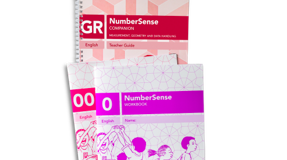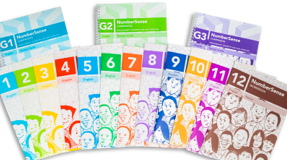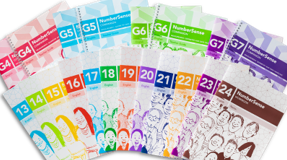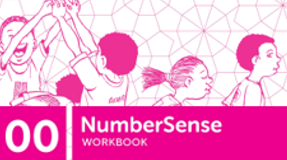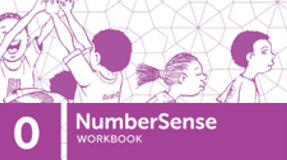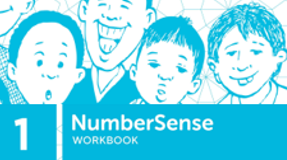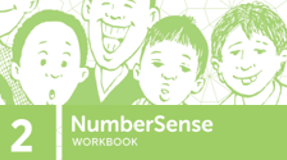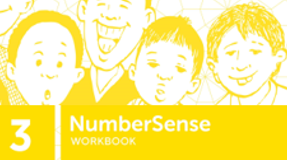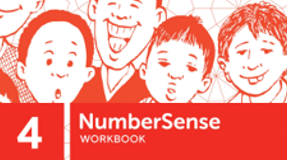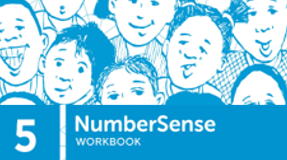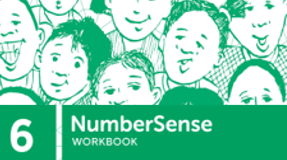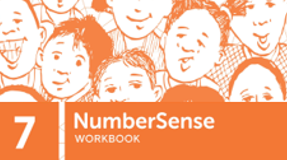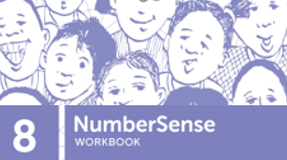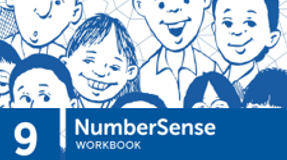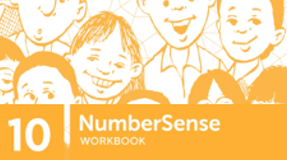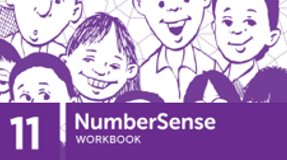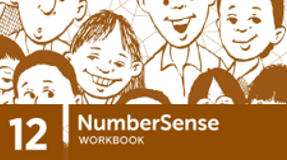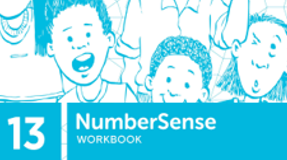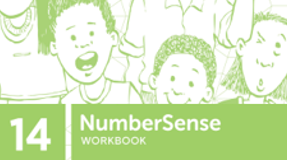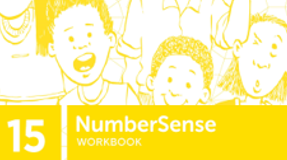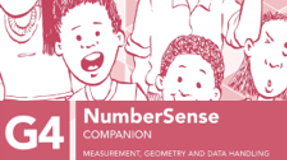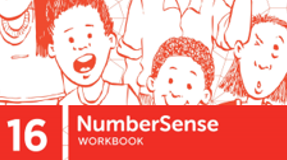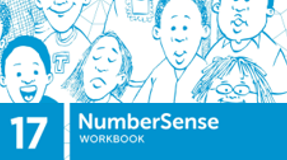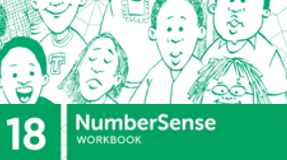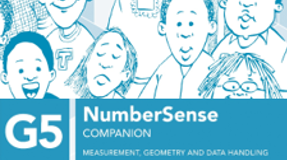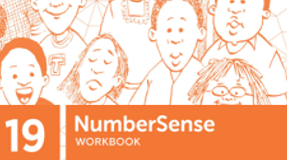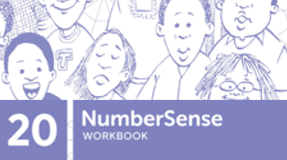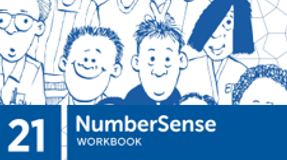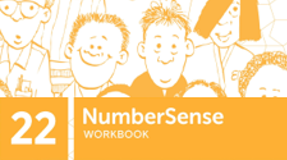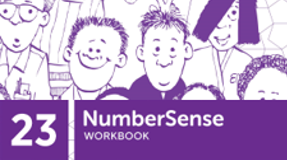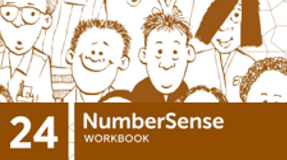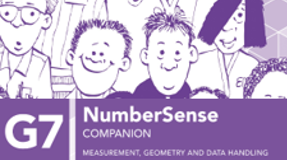Your cart is empty
NumberSense Workbooks
- NumberSense Overview
The NumberSense Mathematics Programme
A strong sense of number is at the heart of being able to do mathematics. Number sense is developed in the early years of schooling. The NumberSense Mathematics Programme has been created to support children’s development of a robust sense of number and a deep understanding of mathematics. The series is responsive to the developmental needs of children, is informed by current research on how children learn mathematics and provides a comprehensive mathematics solution for Grades R to 7.
In the early workbooks, the development of number sense starts with foundational concepts and understandings in a low number range. As children progress through the series, they are supported and encouraged to develop increasingly sophisticated strategies and deeper understanding in higher number ranges. The NumberSense Mathematics Programme (NumberSense and Companion Workbooks and Resources) provides daily practice. Children should – if they are working in the correct book – be able to work independently from one page to the next, asking for help and guidance if needed. The NumberSense Mathematics Programme is aligned with the South African mathematics curriculum. That said, the way in which topics are addressed does not always coincide with the sequence of the current CAPS document. Concepts in the NumberSense Mathematics Programme follow a developmental trajectory and are visited and revisited on a regular basis. With the completion of each workbook, a child “covers the curriculum” and by completing the workbooks intended for each year, the child does so several times.
Features of the NumberSense Workbooks
The NumberSense Workbooks:
- Provide a daily worksheet of independent practice activities that focus on foundational mathematics skills that are predictive of future success in mathematics.
- Provide a comprehensive mathematics programme for Grades R to 7 that addresses the Learning Outcomes: LO1: Numbers, Operations and Relationships and LO2: Patterns, Functions and Algebra.
- NOTE: when combined with the NumberSense Companion materials, the NumberSense Workbooks and the NumberSense Companion materials provide a comprehensive mathematics programme for Grades R to 7 that addresses all the Learning Outcomes.
- Support to teachers who provide differentiated instruction according to the developmental levels of the children in their class by making it easy for different children to work in different workbooks.
- Are CAPS aligned in their approach to teaching and learning mathematics that focuses on whole class and small group teaching.
- Adopt an integrated and spiral approach to concept development: integrated in that topics are not presented in isolation and/or in blocks; spiral in that all topics are continuously visited and revisited. Children will typically work on all the important LO1 and LO2 concepts during each two-week cycle.
- Adopt an approach to number development that recognises that children can do different activities with numbers in different number ranges.
- They can: rote count in a high number range; rational count in a lower number range; read and write numbers in a different number range; order and compare numbers in a still different number range and do calculations in a lower number range.
- Do not teach calculation methods but rather develop confidence in calculating using a range of age, grade and number range appropriate calculation strategies. The workbooks use pattern and structure to reveal calculation strategies that can be generalized across number ranges.
- Are available in all official South African languages for Grades R to 3 and in English and Afrikaans for Grades 4 to 7.
- NumberSense Workbooks by Grade
Who can use the NumberSense Mathematics Programme?
The richly-illustrated and engaging workbooks are used in a wide range of different ways: from schools who use the NumberSense Mathematics Programme as their mathematics programme, to schools that use the NumberSense Mathematics Programme as an integral part of both their extension and remediation programmes, corporates and volunteer organisations that provide the NumberSense Mathematics Programme to children and schools as part of their corporate social investment projects, to parents who homeschool their children. As the NumberSense Mathematics Programme is being used more widely, the body of both anecdotal and more rigorously researched evidence in support of the efficacy of the series is growing.
In all applications, the programme allows for differentiated learning support, independent engagement by children and the opportunity to experience mathematics as a meaningful, sense-making activity. Teachers and parents play an important role in the success of the programme. Not only is there a need to ensure that children are working in the most appropriate workbook, but teachers also need to monitor children’s progress for the identification of problems, misunderstanding and necessary interventions. Furthermore, it is critical that teachers and parents discuss the activities with the children: ask children to explain their answers, describe any patterns they may have observed and invite them to ask questions. This contributes to their development of a strong sense of number.
Grade R- Two 48-page NumberSense workbooks per year.
- Grade R teachers will have to mediate the activities in the workbooks with the children.
- A Teacher Guide and a set of classroom activities that assists teachers with measurement, geometry and data handling.
Grades 1-3- Four 48-page NumberSense workbooks per year (a page a day).
- A Teacher Guide and a set of classroom activities for each grade that assists teachers with measurement, geometry and data handling.
- A workbook per term and a page per day. In the Foundation Phase the workbooks are used to consolidate the daily mat work sessions.
Grades 4-7- Three to four 48-page NumberSense workbooks per year (a page a day).
- Children complete pages in the workbooks in preparation for the focus group sessions with the teacher.
- An 80-page Companion workbook for each grade that deals with measurement, geometry and data handling. The workbooks complement and complete the NumberSense curriculum offering for Grades 4 to 7.
- Selecting the initial NumberSense workbook for a child
Children will benefit most from the NumberSense Mathematics Programme if they start with the workbook that matches their stage of number sense development. In that way they will be able to work confidently and independently through the workbook. The workbooks are developmental in nature. Each workbook builds on the concepts and skills developed in the previous workbook. To gain as much as possible from the workbook series, children should work through the materials in the sequence that they appear in the workbook.
Use the NumberSense Workbook Grade Level Guide to determine the ideal workbook for a child based on their grade and the time of the year. Then start with the sample pages (refer to the next section) from the workbook at least four workbooks before the ideal one.
- Let the child work through these pages by themselves.
- If the child finds the activities on the pages too easy and gets all the answers correct, repeat the exercise with the sample pages from the next workbook.
- If the child struggles with the pages, then repeat the exercise with the sample pages from an earlier workbook in the series.
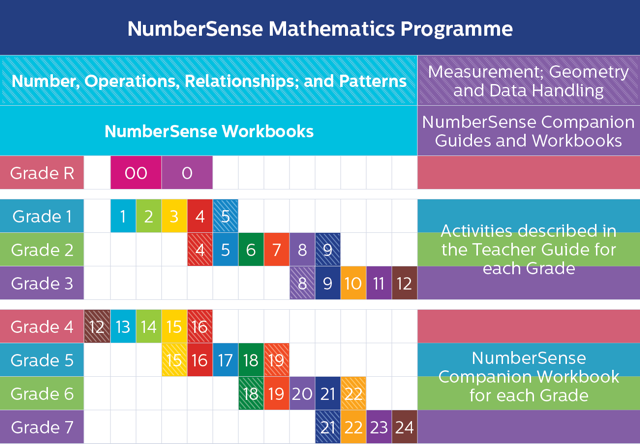
The best initial workbook for a child is the workbook before the one in which the child starts to struggle. Having decided on an initial workbook for a child, let them work through that workbook and those that follow at a pace of at least one page per day.
The NumberSense Companion Workbooks are structured differently in that there is one book per year for each grade (Grade 4-7).
As with the NumberSense Workbooks:- There are no section headings.
- Activities are not grouped by curriculum topic, instead, topics are visited and revisited throughout the year.
- For some activities, the teacher will need to supply materials or have access to resources – it is important to plan each lesson (page/activity) well in advance.
(See our NumberSense Companion Teacher Guides here for more detail).
-
Using the Sample Pages
To help you choose the NumberSense Workbook that is most appropriate for a particular child, three sample pages are available for each of the 26 workbooks in the series. These sample pages are available in all of the languages that the workbooks have been translated into. The purpose of these sample pages is to assist you in deciding on the first workbook that a child will start working in.
Start with the workbook that matches the child’s stage of number sense development. In that way they will be able to work confidently and independently through the workbook. The workbooks are developmental in nature. Each workbook builds on the concepts and skills developed in the previous workbook. To gain as much as possible from the workbook series, children should work through the materials in the sequence that they appear in the workbook.
-
Grade R Sample Pages
NumberSense Workbooks 00 and 0.
-
Grade 1 Sample Pages
NumberSense Workbooks 1, 2, 3 and 4.
-
Grade 2 Sample Pages
NumberSense Workbooks 5, 6, 7 and 8.
-
Grade 3 Sample Pages
NumberSense Workbooks 9, 10, 11 and 12.
-
Grade 4 Sample Pages
NumberSense Workbooks 13, 14, 15 and the Grade 4 Companion Workbook.
-
Grade 5 Sample Pages
NumberSense Workbooks 16, 17, 18 and the Grade 5 Companion Workbook.
-
Grade 6 Sample Pages
NumberSense Workbooks 19, 20, 21 and the Grade 6 Companion Workbook.
-
Grade 7 Sample Pages
NumberSense Workbooks 22, 23, 24 and the Grade 7 Companion Workbook.
